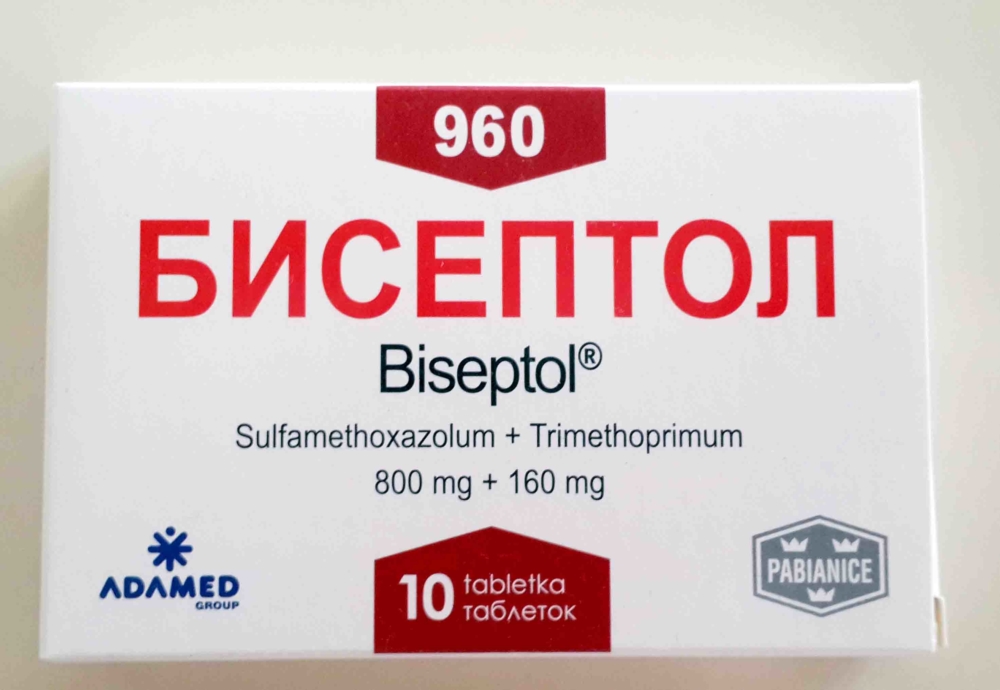Biseptol is one of the popular antimicrobial agents used to treat both adults and children. Since many people are lost if you need to choose an antibiotic, you should understand what Biseptol is and what this medicine helps with.
Material Content:
Description of release forms and composition
Biseptol is a powerful antibacterial agent based on two potent components - sulfamethoxazole and trimethoprim. The first is an antimicrobial substance from the group of sulfonamides, it differs in bacteriostatic action. The second component is an antibiotic with a similar effect. These drugs are part of Biseptol in a ratio of 5: 1, and the combination of active substances is called “co-trimoxazole”.
The medicine has a bactericidal effect, is active against a number of pathogenic microorganisms. Biseptol blocks the synthesis of folates in the cells of pathogenic microorganisms, thereby reducing their population.
In pharmacies, there are three forms of release with different dosages and formative components:
- Biseptol tablets. Dosage - 120 or 480 mg of the active substance. The composition also contains starch, talc, magnesium stearate, shell components and stabilizers. Available in 20 and 28 tablets per pack.
- Biseptol suspension. One therapeutic dose (measuring spoon or 5 ml) contains 240 mg of the combined preparation, as well as macrogol, citric acid, dyes and stabilizers, flavoring, propylene glycol and a number of other substances. Available in dark glass bottles of 80 ml.
- Concentrate for injections and droppers. Release form - ampoules of 5 ml. In 1 ml - 96 mg of an antimicrobial agent. The composition contains alcohols, propylene glycol and sodium hydroxide.
The form of release depends on the evidence. For outpatient treatment, tablets or suspension are prescribed, the solution is used mainly in a hospital.
The original drug is produced by a Polish pharmaceutical company. An affordable domestic analogue is Co-trimoxazole tablets.
What helps Biseptolum
The combined antimicrobial agent is used in the treatment of various diseases caused by the activity of bacteria or infections. The drug is effective against streptococci, staphylococci, Escherichia coli, salmonella, chlamydia and protozoa. Biseptolum is advisable to apply for certain types of fungal infections, pneumonia, diseases of a gonorrheal nature.
Indications for use:
- infectious pathologies of ENT organs: otitis media, sinusitis, pneumonia, bronchitis, etc .;
- bacterial brain damage: meningitis, abscess;
- genitourinary diseases: prostatitis, urethritis, pyelonephritis;
- gastrointestinal tract diseases: paratyphoid, dysentery, diarrhea of an infectious nature.
The drug penetrates well into all affected tissues and is characterized by its quick action, due to which the drug can be used for any infectious diseases caused by microbes sensitive to its action. However, Biseptol has a limited spectrum of activity and does not act against pale treponema, Koch bacillus, Pseudomonas aeruginosa. This necessitates a detailed examination to determine the causative agent of the disease before taking the medicine.
- The drug does not have antiviral activity, therefore it is ineffective in influenza and SARS.
It is not recommended to take the medicine without a doctor's prescription because of the risk of developing superinfection and side effects.
Instructions for use and dosage
For adults, the drug is recommended in tablets. The optimal form is Biseptol 480 mg tablets. The medicine is taken in 1 pc. morning and evening, immediately after eating. At the end of the course of treatment, which on average takes up to 2 weeks, maintenance therapy with small doses of the drug can be prescribed - 120 mg in the morning and evening. Duration is determined individually and depends on the type of disease.
Children in the age range of 6-12 years should take one tablet (480 mg) per day.
The optimal form of release for children is a suspension. It has a pleasant taste, so the kids do not experience discomfort when taking the medicine. The drug is approved for use in pediatric practice and is prescribed for children older than two months. A medicine in this form should be taken every 6 hours. Dosage depends on the body weight of the child. For every 8 kg of weight, 5 ml of suspension should be taken. So, with a body weight of 16 kg, 10 ml of the drug are taken, 24 kg - 15 ml of syrup, 40 kg - 25 ml and so on, according to the weight. As prescribed by the doctor, the standard dosages recommended in the instructions are subject to change.
During pregnancy and lactation
The drug can not be used during pregnancy and lactation. If necessary, treatment with an antimicrobial agent during breastfeeding should be weaned and transferred to special mixtures. This is due to the fact that the drug passes into breast milk in large quantities.
Contraindications, side effects and overdose
The medicine can not be taken with intolerance to the active substance, severe pathologies of the liver and kidneys, anemia caused by a pathological lack of folic acid. The drug is not prescribed for patients undergoing chemotherapy for cancer, as well as for the need for long-term use of barbiturates, sulfonylureas and indirect anticoagulants.
An antibacterial agent can cause severe side effects: liver necrosis, anemia, myocarditis, hepatitis, renal failure.Such reactions are very rare and are due to the long-term use of large doses of the antibiotic.
The most common side effects are digestive disorders - diarrhea, nausea and vomiting, stomach pain. The drug often causes allergic reactions, characterized by a skin rash.
- An overdose of Biseptol is manifested by headache, symptoms of severe depression and depression of bone marrow functions, confusion, nausea. To prevent complications, you need to rinse the stomach and urgently call a doctor at home.
Despite the large number of indications and rapid action, Biseptolum refers to potent drugs that can provoke severe violations. Do not use the medicine without a doctor's prescription.














